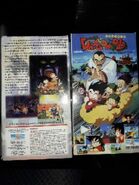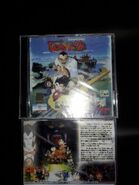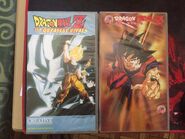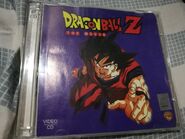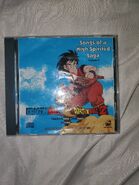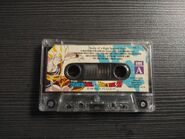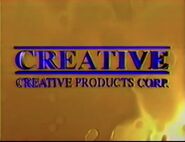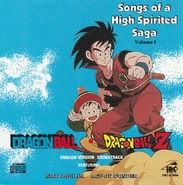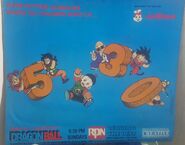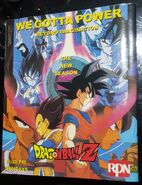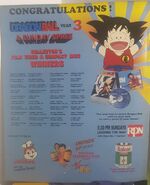|
This article is about the |

Creative Products Corp. logo
In the Philippines, both Dragon Ball and Dragon Ball Z were dubbed into English by the Creative Products Corporation. The dub ran from 1993 until 1997. The Creative Products Corporation dub (also called Creative Products Corp., Creative Products, Creative, RPN 9 dub) was supposedly only aired once on the Filipino TV channel RPN 9. It was briefly replaced by the Taglish dub, then eventually the Tagalog dub, both of which were broadcasted on GMA 7; the former in 1997/1998 and the latter in 1999.
History[]
Following the failed attempt at dubbing Dragon Ball in the United States by Harmony Gold USA, a company called the Creative Products Corporation produced an English dub of Dragon Ball and Dragon Ball Z exclusively in the Philippines that aired on RPN 9 (currently known as CNN Philippines). The company was owned by a couple named William and Nannie Co. Nannie recalls in an interview that William got the idea to air Dragon Ball Z in the Philippines after he had taken a trip to Thailand in 1992 and saw a poster of the anime in the backseat of a friend's car and was told it was "Asia's number one cartoon series". Afterwards, William contacted the Hong Kong licensor of Toei Animation and was able to obtain the legal rights to air the show over local Filipino television in 1993.
Dragon Ball[]
On April 18, 1995, Creative Products created their dub of Dragon Ball. They attempted Dragon Ball Z beforehand, but due to unknown reasons, it was canceled in spite of its popularity, and soon afterwards came their dub of Dragon Ball. This dub lasted until the end of the King Piccolo Saga (episode 122). As of now, no episodes of this dub currently exist. However, TV promos and TV rips of the opening and ending being aired on RPN 9 do exist, along with Nannie Co stating: "What's showing at present (August 10, 1996) is Dragon Ball, which is an earlier version of the series showing a young Gokou." As of March 9, 1997, Dragon Ball was still airing on RPN 9.
According to recent rumors and evidence, the Creative Products dub of Dragon Ball was supposedly re-aired on GMA 7 at some point during the channel's early history.[1][2][3]
Dragon Ball Z[]
During some point in 1993, Dragon Ball Z was first broadcasted on local Filipino television on RPN 9. Currently, 11 episodes out of the initial 26 have been found (episodes 11-12, 14-15, 17-18, 20, 23-26) of this dub of Dragon Ball Z. The dub contained next and last episode previews for every episode, the original Japanese title cards, and the Japanese opening and ending songs. This was the first of Creative Products' dubs of the franchise.
In early 1996, they would continue their dub of Dragon Ball Z from where they left off, after they had begun their dub of Dragon Ball. It lasted up until when Vegeta killed Dodoria (episode 49) and ran congruently with their broadcast of Dragon Ball. No episodes exist for the continued dub, nor was it mentioned by Nannie Co in any official interview. However, promos from the time period of it do exist.
Films[]
From what is known, Creative Products has made a total of 4 English dubbed films. They were all released as stitched compilations (similar to Harmony Gold's dubs of Dragon Ball movies 1 and 3). The first of which was Dragon Ball Z: The Greatest Rivals, which was a featured presentation of Dragon Ball Z movies 5 and 6 (Cooler's Revenge and The Return of Cooler). This feature was released theatrically by July 11, 1996, in over 30 Metro Manila theaters and received an extremely limited VHS release; only sold at film festivals surrounded around Dragon Ball that were held by the popular guest, Gino Padilla. The VHS was made available by November 6, 1996.[4]
Although not mentioned nor distributed by Creative Products, they also dubbed Dragon Ball movies 2 & 3 (Sleeping Princess in Devil's Castle and Mystical Adventure) sometime between 1995 and 1997. These movies are believed to have aired on TV, although that is unconfirmed. They were released onto VHS and VCD by Regal Entertainment/Regal Home Video only in the Philippines (despite there being an American FBI warning on the back of the VHS) between 1996 and 2000.
There was also a compilation of Dragon Ball Z movies 10 & 11 (Broly - Second Coming and Bio-Broly) released onto VHS and VCD, that was dubbed into English and played theatrically in the Philippines in early 1998. Creative Products was likely not involved with this dub, as many of the voice actors in this dub sound nothing like the voice actors from neither the English Creative Products dub nor the early Tagalog dub and retains none of the same name changes in either dub. It was most likely done by the Solar Entertainment Corporation/Solar Home Video, who distributed it onto VHS, while the VCD release was distributed by Warner Home Video Philippines but are both still credited to Solar Entertainment. There was also a re-release of the VHS. The re-release credits Magnavision for the distribution, features Solar Entertainment's updated information (Solar Team Entertainment Incorporated) and has very minor cover art/layout differences.
Soundtrack[]
The dub as a whole seems to use the original Japanese soundtrack provided by Shunsuke Kikuchi. However, opening songs, ending songs and some insert songs got their own English renditions. They were recorded by the guest star Gino Padilla, and a short-lived singing and dancing group of children and teenagers named Age of Wonder. They recorded full-length versions of these tracks and they were released onto a licensed CD and cassette named Dragon Ball • Dragon Ball Z: Songs of a High Spirited Saga - Volume I. Despite the name, future volumes are confirmed to not exist.[5]
Track Listing[]
- Track 1 - CHA-LA HEAD-CHA-LA (Movie Theme)
- Track 2 - Get That Dragon Ball
- Track 3 - A World Filled With Love
- Track 4 - You Are the Hero
- Track 5 - Special ZENKAI Power
- Track 6 - CHALA-HEAD-CHA-LA
- Track 7 - Go for No. 1
- Track 8 - Love Light
- Track 9 - You Are the Hero (Movie Theme)
Both the CD and cassette contain Minus One renditions of these songs (karaoke's) (these tracks are on the opposite side of the cassette), with a total of 18 tracks in all.
Age of Wonder[]
- Trina Alcantara
- Millan Anderson
- Inah Cacho
- Mazie Cajucom
- Peige Castelvi
- May de Jesus Palacpac
- Carlo Lorenzo
- Isko Mariano
- Carlo Natividad
- Jason Ocampo
- JC Tizon
- Jonard Yanzon
Timeline & Time Slots[]
The first 26 episodes (right as Goku returns from the afterlife) of Dragon Ball Z aired in 1993 on RPN 9. This would be the first time Dragon Ball would ever grace Filipino television. The original run of Dragon Ball Z on RPN 9 ran on a 5:30 PM time slot every Sunday.[6] There would be an extended break after the last episode of Dragon Ball Z had aired.
On April 18, 1995, Dragon Ball was brought over to RPN 9, lasting from (around) episodes 1 - 122 (the end of the Demon King Piccolo saga). It was operating underneath a 7:30 PM time slot every Thursday. It's unknown when the last episode was aired. However, the last known broadcast of the dub was easily as late as March 9, 1997. It would have also been during this time that Creative Products would dub Dragon Ball movies 2 & 3. Although, release dates for those do not exist.
At some point in early 1996 — while Dragon Ball was being aired — Dragon Ball Z was brought back to RPN 9 for a new "season". This continued on from where they had previously left off in 1993. It was from episodes 27 - 49 (right when Vegeta kills Dodoria). This broadcast was operating underneath the old 1993 timeslot of 5:30 PM every Sunday.
Dragon Ball Z: The Greatest Rivals — a feature-length combined edit of Dragon Ball Z movies 5 & 6 by Creative Products — would be shown theatrically in over 30 Metro Manila theaters by July 11, 1996. A VHS release was made available by November 6, 1996 (courtesy of Magnavision), only at film festivals in the Philippines held by Gino Padilla and Age of Wonder. It's believed that, after this point, no more content from Dragon Ball Z would be dubbed by Creative Products.
On March 9, 1997, Dragon Ball would move to a brand-new time slot, this one being what Dragon Ball Z use to run on; 5:30 PM every Sunday. Later the same year, Creative Products' dub of Dragon Ball would cease from broadcasting and wouldn't been seen again on RPN 9.
Censorship[]
Nannie Co has stated in an interview that, "During the dubbing process, we edit out scenes that we think are too violent or those with sexual implications to come up with a sanitized version for kids." This quote was from August 10, 1996. Meaning that this was a censored dub. However, if you watch the currently available episodes of Dragon Ball Z, you'll find a very uncensored version of the show, a very accurate script, seemingly no censorship towards nudity, words such as "Hell" and "bastard" are left unaltered, etc... This was stated by Nannie in the same interview: "We used to enjoy a General Patronage rating for one year, but the MTRCB became more strict and gave us a Parental Guidance rating." These ratings she's talking about are ratings given to visual media in the Philippines, not too different from the MPAA TV ratings in the United States. Essentially, for one year, their show could be viewed by anyone of any age, but a year in, the show was targeted by the MTRCB and was given a different rating. This new one only being suitable for ages 13 and up. Anyone under 13 needed supervision from a parent. And since Dragon Ball Z was the first series they dubbed, it easily fit underneath this first year of freedom, meaning not as much censorship.
Not much of Creative Products' dub of Dragon Ball currently exists. The movies do exist, however. The movies show at least a semblance of censorship compared to how Creative Products handled Dragon Ball Z in 1993. In movie 2, the beginning scene where Krillin gives Master Roshi a dirty magazine is said to be a fitness magazine and a close-up shot of Bulma's breasts being poked with a needle is removed. In movie 3, any and all scenes with General Blue are removed, including his scene at the beginning of the film with his encounter against Mercenary Tao. This means it's never explained how Master Shen is collecting the Dragon Balls, what Ran Ran is, and the opening scene with the Mifan Army is never elaborated on in their scene attacking a town.
Episode Titles[]
Dragon Ball Z[]
- ?
- ?
- ?
- ?
- ?
- ?
- ?
- ?
- ?
- ?
- A Planet Disappeared
- Falling Down to Hell (Preview Title: Don't Sleep on the Snake Road)
- ? (Preview Title: King Yama's Forbidden Fruit)
- Princess Snake's Sweet Temptation
- ? (Preview Title: Running Away from the Destined)
- ? (Preview Title: Gohan's Island Adventure)
- The Long Way to Victory
- The End of the Snake Road
- ?
- Legend of the Saiyans
- ?
- ?
- Yamcha's Death
- Falling on the Battlefield
- ?
- The Long Wait for Son Goku
Home Media[]
- Dragon Ball Movies 2 & 3 (Released as just "Dragon Ball") (VHS & VCD)
- Dragon Ball Z Movies 5 & 6 (Released as "Dragon Ball Z: The Greatest Rivals") (VHS)
- Dragon Ball Z Movies 10 & 11 (Released as "Dragon Ball Z: The Movie") (Not done by Creative Products) (VHS & VCD)
- Dragon Ball • Dragon Ball Z: Songs of a High Spirited Saga - Volume I (CD & Cassette)
Cast[]
Dragon Ball Z (1993) Cast[]
- Nesty Calvo Ramirez - Goku, Master Roshi, Oolong, Atla, Greger, Princess Snake Servant B, Bubbles, Saibaman
- Ethel Lizano - Gohan, Krillin, Turtle, Launch (Bad), Princess Snake, Narrator, Gregory, Princess Snake Servant C, Fortuneteller Baba, Space Pod Computer
- Apollo Sheikh Abraham - Ox-King, Mr. Popo
- Michelle Elizabeth Frankenberger Pellicer - Bulma, Chi-Chi, Upa, Chiaotzu, Puar, Launch (Good), Lemlia, Princess Snake Servant A
- Raymond Martin Buyco - Piccolo, Raditz, Vegeta, Nappa, Yamcha, Korin, Yajirobe, Kami, Arlian Riders, Arlian Prison Guard, King Moai, Street Sweeper, Cop, Scarface, Shorty, News Reporter, King Yemma
- Richard Jonson - Tien Shinhan
Dragon Ball Cast[]
- Nesty Calvo Ramirez - Goku
- Ethel Lizano - Launch (Bad)
- Unknown - Ninja Murasaki
Dragon Ball Z: The Greatest Rivals Cast[]
- Nesty Calvo Ramirez - Goku, Bardock, Master Roshi
- E.J. Galang - Gohan
- Raymond Martin Buyco - Piccolo, Korin, Vegeta
- Apollo Sheikh Abraham - Krillin, Oolong, Cooler, Frieza, Mr. Popo, Moori
- Ethel Lizano - Yajirobe, Icarus
- Michelle Elizabeth Frankenberger Pellicer - Chi-Chi
- R.J. Celdran - Salza
- Manuel R. Abello - Dore
- David Soon - Neiz
- Hazel Lizano - Dende, Crowds
- Bob Karry - Narrator, Crowds
Dragon Ball (Movies) Cast[]
- Nesty Calvo Ramirez - Goku, Master Roshi, Shu, Narrator
- Apollo Sheikh Abraham - Krillin, Yamcha, Oolong, Emperor Pilaf, Bora, Senbei Norimaki, Igor(?)
- Raymond Martin Buyco - Korin, Tien Shinhan, Lucifer
- Ethel Lizano - Bulma, Launch (Bad), Mai, Chiaotzu
- Michelle Elizabeth Frankenberger Pellicer - Puar, Launch (Good)
- R.J. Celdran - Master Shen, Mercenary Tao
- Manuel R. Abello - Ghastel(?)
- Unknown - Upa, Turtle, Major Metallitron, Gregor, Arale Norimaki
Name Changes[]
Most characters keep their original names. For the most part, it's usually either how its pronounced or how its spelled that is different.
- Puar - Paul (Later changed to Puar - "Puh • Wur")
- Krillin - Kririn
- Bulma - Bluma/Blooma (Later changed to Bulma)
- Bardock - Bada
- King Yemma - Yama
- Dore - Barky
- Icarus - Baby Camilla
- Upa - Little Feather
- Mercenary Tao - Tao Pai Tek
- Launch - Lanch
- Master Roshi - Master Muten (Later changed to Master Buten)
- Master Shen - Master Crane
- Gregor - Tiny Tim
- Igor - Twinkles
- Fortuneteller Baba - Granny Fortune Teller
- Kamehameha - Kamehame Wave
- Power Pole - Stretch Stick
- Flying Nimbus - Kintoun Cloud
- Dodon Ray - Dodo Wave
- Senzu Bean - Magic Bean
- World Martial Arts Tournament - Supreme Martial Arts Tournament
- Devil's Castle - Castle of Evil
- Devil's Hand - Hand of Evil
- The Big Gete Star - Metal Galactic Starship
Miscellaneous[]
Television[]
- General Manager/Producer - William Co
- Vice President Marketer/Producer - Nannie Co
- Producer - Walter Co
- Executive Producers - Creative Products Corporation, Joji Z. Ravina
- Production Managers - Michelle Elizabeth Frankenberger Pellicer, Nick Emocling
- Post-Production Facilities - Phil. Information Agency, LVN Pictures
- Dubbing/TV Director - Rio A. del Rosario
- Scriptwriters - Michelle Elizabeth Frankenberger Pellicer, Nesty Calvo Ramirez, Rio A. del Rosario
- Casting Director - Ethel Lizano
- Dubbing Supervisors - Ethel Lizano, Michelle Elizabeth Frankenberger Pellicer
- Film Editor - “Apostol”
Music[]
- Music - Shunsuke Kikuchi, Chiho Kiyooka, Takeshi Ike
- Music Recording Supervisors - Eugene Villaluz, Alwin Cruz
- Musical Arrangers - Rudy Lozano, Marc Lopez, Mel Vellina
- Vocal Arrangers - Vicky Salvador, Moy Ortiz, Mel Villena
- Vocal Coaches - Vicky Salvador, Eugene Villaluz, Cecille Posadas
- Lyricists/Lyrics Translators - Vicky Salvador, Edith M. Gallardo, Moy Ortiz
- Dance Choreographer - Para Isidro
- Director - Chris Millado
- Guest & Play Actor/Vocalist - Gino Padilla
- Show Guests - Jolina Magdangal, Tony Lambino
- Line Producer - Joji Z. Ravina
- Supervising Producers - Eugene Villaluz, Alwin Cruz
- Creative Consultant - Rio A. del Rosario
- Sound Engineering - Jun Reyes
- Mastering/Sequencing - Chris Reyes
- Production Assistant - Baby Hugo-Estabaya
- Recording/Mixing Engineers - Jun Reyes, Chris Reyes
Trivia[]
- Despite all the info we have of this dubs production, this is still one of English Dragon Ball's largest lost media cases, second only to the Animax Asia dub.
- Creative Products was the very first company to dub Dragon Ball Z in English and they were the second to dub Dragon Ball in English.
- The next episode preview music for Dragon Ball Z uses the instrumental rendition of "CHA-LA HEAD-CHA-LA" rather than the preview theme.
- The instrumental of CHA-LA HEAD-CHA-LA in Age of Wonder's rendition of the song is taken directly from the Cantonese dub's full version.
- The instrumental of Makafushigi Adventure! from this dub was also used in the first Indonesian dub of Dragon Ball.
- While the show was being aired, it was advertised as "Asia's No. 1 Cartoon", which is something Funimation themselves would go on to use in a similar promo for their dub in association with BLT Productions.
- Nannie Co says in passing during an interview that they have a Japanese translator. Meaning that this dub is derived from the original Japanese dub and is much more accurate than most English dubs of the franchise.
- This dub marks the first time the name "Wolf Fang Fist" (officially spelt as "Wolf-Fang-Fist") was used. The Japanese name is "Fist of the Wolf Fang Gale". This name was also used in Funimation's BLT dub of the Dragon Ball series in the fall of 1995, however, it would have been used in Creative Products' dub on May 16, 1995. Funimation most likely got the name from Creative Products, similar to how they got the name Master Roshi from Harmony Gold.
- During a television interview with Age of Wonder, Gino Padilla and Nannie Co, in the background, we can see and hear Carlo Lorenzo (a member of Age of Wonder) singing the lyrics to Dragon Ball Densetsu ("The Dragon Ball Legend"), which was an insert song used at various points during the Red Ribbon Army Saga and as the ending theme for Dragon Ball movie 3. Despite this and the fact that movie 2 starts out with Age of Wonder's rendition of Makafushigi Adventure!, the Japanese song is still what plays at the end of the film.
- This is the only English dub of Dragon Ball to have used a female narrator.
- In very early parts of the Tagalog dub, Nesty Calvo Ramirez can be heard voicing Goku in Tagalog.
- According to May de Jesus Palacpac — a former member of Age of Wonder — she recalls having used Japanese cassette tapes as the basis for their tempo when recording and practicing their music. In addition, she adds that no further albums were made outside of Songs of a High Spirited Saga, and that they did, in fact, make other songs not included in the aforementioned album. Although, there were very few (one of which presumably being Dragon Ball Densetsu), were never officially recorded, and were only performed at their live showings.
- According to Jefferson Utanes, the second voice of Goku in the Philippines and current holder of the role, the first voice of Goku, Nesty Calvo Ramirez, was always intended to be the voice of Goku in the Filipino dubs; both English and Tagalog. He was only replaced out of necessity when Nesty moved out of the Philippines and into the United States (where he still currently resides) after his parents had selected him to be the principle of a school that they had built. Jefferson Utanes claims to have replaced Nesty on August 1, 2000.
Gallery[]
References[]
- ↑ Dragon Ball Z - Goku turns Super Saiyan [1st Tagalog dub / Tagalog English dub]. Youtube. Retrieved on March 23, 2022.
- ↑ POKEMON and WEAREANIME COMMERCIAL GMA7. Youtube. Retrieved on February 21, 2022.
- ↑ GMA Network - We Are Animé plug - December 1999. Youtube. Retrieved on April 28, 2022.
- ↑ This video was recorded back in November 2, 2019 just hours before I sent the Greatest Rivals VHS tape to @Fumeicom and have it digitally restored!. Twitter. Retrieved on September 3, 2022.
- ↑ Songs of a High-Spirited Saga Vol. 1. dbforever.wordpress. Retrieved on September 3, 2022.
- ↑ Manila Standard - Aug 10, 1996. Google News.
External links[]
- Manila Standard, Google News "Enter the Dragon Ball Z"
- Manila Standard, Google News "Hope and Heroism in Dragon Ball Z"
- Manila Standard, Google News "Values to Learn and Live by"
- Creative Products Corporation dub by Kanzenshuu
- FumeiCom
- jdrayas
- Dragon Ball & Dragon Ball Z Promos (Creative Products, Solar Entertainment) (sandiessss)
- Android18's DragonBall Philippines Page


